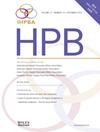Safety and efficacy of tranexamic acid in hepatic surgery: a meta-analysis of randomized controlled trials
IF 2.4
3区 医学
Q2 GASTROENTEROLOGY & HEPATOLOGY
引用次数: 0
Abstract
Background
Hepatic surgeries involve substantial bleeding risk, associated with perioperative morbidity and mortality. While tranexamic acid (TXA) reduces blood loss in other surgeries, its efficacy in hepatic procedures remains unclear. This meta-analysis evaluates TXA's safety and effectiveness in liver surgeries.
Methods
We systematically reviewed randomized controlled trials published until April 2025 from PubMed, Scopus, Embase, and Cochrane CENTRAL. Studies comparing TXA with placebo in adult elective liver surgeries were included. Primary outcomes were blood loss and mortality, while secondary outcomes encompassed blood transfusion needs, thromboembolic, and adverse events. The Cochrane Risk of Bias tool was used for quality assessment.
Results
Six trials comprising 1875 patients undergoing liver resections or transplants were included. TXA did not reduce intraoperative blood loss (MD = −0.16 L; 95 % CI: −0.50 to 0.18; I2 = 92 %) or mortality (RR = 1.04; 95 % CI: 0.58 to 1.87; I2 = 4 %). Thromboembolic risk showed no significant difference overall (RR = 1.58; 95 % CI: 0.94 to 2.64; I2 = 0 %), but sensitivity analysis indicated a potential increased risk (RR = 1.70; 95 % CI: 1.01 to 2.87).
Conclusion
Our findings suggest that TXA does not improve bleeding or mortality outcomes in liver surgeries and may increase thromboembolic risk. (PROSPERO number, CRD42024585513)
氨甲环酸在肝脏手术中的安全性和有效性:一项随机对照试验的荟萃分析。
背景:肝脏手术存在大量出血风险,与围手术期发病率和死亡率相关。虽然氨甲环酸(TXA)在其他手术中可以减少失血,但其在肝脏手术中的疗效尚不清楚。这项荟萃分析评估了TXA在肝脏手术中的安全性和有效性。方法:我们系统地回顾了截至2025年4月在PubMed、Scopus、Embase和Cochrane CENTRAL发表的随机对照试验。比较TXA和安慰剂在成人选择性肝脏手术中的研究被纳入。主要结局是失血和死亡率,次要结局包括输血需求、血栓栓塞和不良事件。采用Cochrane偏倚风险工具进行质量评估。结果:纳入了6项试验,包括1875例接受肝脏切除或移植的患者。TXA未减少术中出血量(MD = -0.16 L;95% CI: -0.50 ~ 0.18;I2 = 92%)或死亡率(RR = 1.04;95% CI: 0.58 ~ 1.87;I2 = 4%)。血栓栓塞风险总体上无显著差异(RR = 1.58;95% CI: 0.94 ~ 2.64;I2 = 0%),但敏感性分析显示潜在的风险增加(RR = 1.70;95% CI: 1.01 - 2.87)。结论:我们的研究结果表明,TXA不能改善肝脏手术中的出血或死亡结果,并可能增加血栓栓塞的风险。(普洛斯彼罗号码,CRD42024585513)。
本文章由计算机程序翻译,如有差异,请以英文原文为准。
求助全文
约1分钟内获得全文
求助全文
来源期刊

Hpb
GASTROENTEROLOGY & HEPATOLOGY-SURGERY
CiteScore
5.60
自引率
3.40%
发文量
244
审稿时长
57 days
期刊介绍:
HPB is an international forum for clinical, scientific and educational communication.
Twelve issues a year bring the reader leading articles, expert reviews, original articles, images, editorials, and reader correspondence encompassing all aspects of benign and malignant hepatobiliary disease and its management. HPB features relevant aspects of clinical and translational research and practice.
Specific areas of interest include HPB diseases encountered globally by clinical practitioners in this specialist field of gastrointestinal surgery. The journal addresses the challenges faced in the management of cancer involving the liver, biliary system and pancreas. While surgical oncology represents a large part of HPB practice, submission of manuscripts relating to liver and pancreas transplantation, the treatment of benign conditions such as acute and chronic pancreatitis, and those relating to hepatobiliary infection and inflammation are also welcomed. There will be a focus on developing a multidisciplinary approach to diagnosis and treatment with endoscopic and laparoscopic approaches, radiological interventions and surgical techniques being strongly represented. HPB welcomes submission of manuscripts in all these areas and in scientific focused research that has clear clinical relevance to HPB surgical practice.
HPB aims to help its readers - surgeons, physicians, radiologists and basic scientists - to develop their knowledge and practice. HPB will be of interest to specialists involved in the management of hepatobiliary and pancreatic disease however will also inform those working in related fields.
Abstracted and Indexed in:
MEDLINE®
EMBASE
PubMed
Science Citation Index Expanded
Academic Search (EBSCO)
HPB is owned by the International Hepato-Pancreato-Biliary Association (IHPBA) and is also the official Journal of the American Hepato-Pancreato-Biliary Association (AHPBA), the Asian-Pacific Hepato Pancreatic Biliary Association (A-PHPBA) and the European-African Hepato-Pancreatic Biliary Association (E-AHPBA).
 求助内容:
求助内容: 应助结果提醒方式:
应助结果提醒方式:


